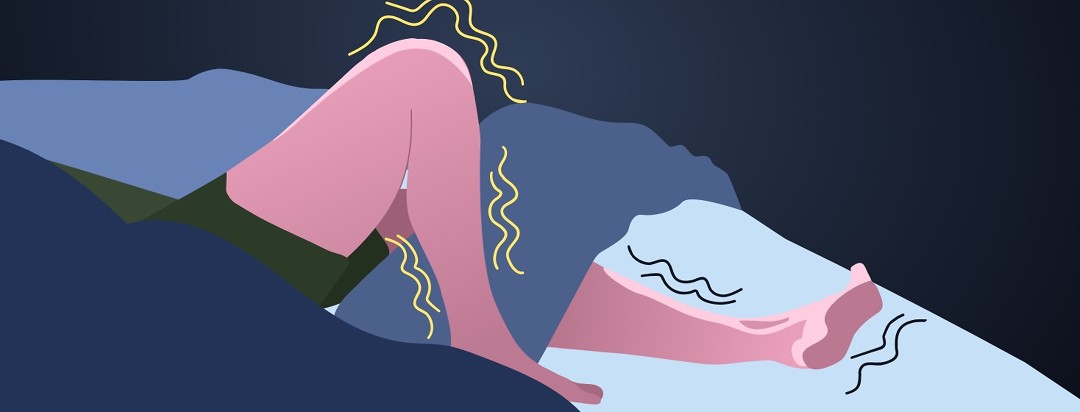The Connection Between Type 2 Diabetes and Restless Legs
Have jumpy legs at night? Do they make it hard for you to fall asleep? You might have a condition common to people with type 2 diabetes (T2D): restless legs syndrome.
What’s restless legs syndrome (RLS)?
This condition is known as a “movement disorder of sleep.” A person with RLS may experience unpleasant sensations in the legs that don’t seem to go away without walking, massage, or other kinds of movement.1 The sensations are described as creeping, crawling, prickling, jittering, burning, tingling that happens deep in the legs. It may include uncontrollable jerking of the toes, feet, and even the legs.2
RLS happens throughout the day, so it’s not only a problem at night. But at bedtime, it’s far more noticeable because it prevents the person who is experiencing these sensations from relaxing and falling asleep. They often need to get up and walk around, take a shower, or stretch, which prevents sleep from taking place, sometimes for a couple of hours.
Once asleep, the sensations cease, but if a person with RLS awakens in the middle of the night, they may then re-experience some of these issues and lose even more sleep trying to find relief. The sleep lost to RLS can result in excessive daytime sleepiness and all the side effects it entails: drowsy driving, fatigue while on the job, less energy for exercise, clumsiness, workplace mistakes, and more.
What causes RLS in people with type 2 diabetes?
You don’t need to have diabetes to experience RLS. People with other chronic conditions, who are pregnant, or who take specific kinds of medications may also experience RLS.
Women, in general experience more RLS than men; a link between low blood iron and RLS may explain why. People of all ages can experience it. For children, complaints of “growing pains” may actually point to RLS in childhood. Some people experience RLS rarely, while others suffer from it every single night. It can also run in families and is especially linked to kidney disease.2
However, there’s a distinct relationship between diabetes and RLS based on the presence of diabetic peripheral neuropathy.
What's diabetic peripheral neuropathy?
Uncontrolled levels of blood sugars can eventually lead to damage to the nervous system. In particular, the nerves of the feet and lower legs are a major target for peripheral neuropathy (peripheral describes hands, arms, legs, and feet).
This nerve damage is known to contribute to the development of RLS. In fact, RLS is considered a common problem in people with T2D.3 Nerve damage isn’t the only factor leading to poor sleep in people with diabetes, either; problems with glucose metabolism are also linked to poor sleep.
RLS affects bed partners too!
If you share a bed with someone with RLS, you may also lose sleep because they’ll twitch, toss, and turn, trying to find relief. They may also get in and out of bed multiple times, which will disrupt your sleep. It’s in your best interest, as their bed partner, to encourage them to seek help for their RLS. It will lead to daytime fatigue and nighttime sleep problems for you if left untreated.2
How to find RLS relief
If you have T2D and RLS, you probably already understand the instinct to move your legs to get rid of the sensation.
Good self-care is your first line of defense against RLS:
- Avoid nicotine, caffeine, and alcohol.
- Practice good sleep hygiene by going to bed and rising at the same time.
- Avoid taking late, long naps. They can also make it hard to fall asleep because they disrupt your circadian sleep drive.
- Increasing your daily exercise (and doing it earlier in the day) can help manage this sleep disorder.
Also, avoid its triggers, such as:3
- Stress and anxiety
- Caffeine in the second half of the day
- Smoking
- Alcohol use
- Sedentary living
- Too much exercise in the evening
- Certain medications (antihistamines, most antidepressants, and major tranquilizers)2
For severe RLS - which can be impossible to live with, painful, and uncontrollable - some medications may help, including:
- Benzodiazepines
- Dopamine agonists
- Gabapentin
- Opioids
Naturally, you’ll need to take great care in using any of these drugs as they all pose adverse side effects.
If this sounds like a problem you might have, discuss it with your primary care physician or diabetes specialist. They should offer ways to treat your RLS so you can get the sleep you need.
Community Poll
How confident are you that you know all the ways you can spend health savings account (HSA) and flexible spending accounts (FSA) funds?

Join the conversation